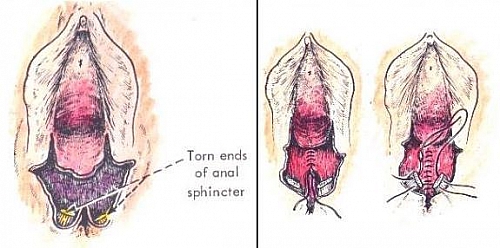Table of Contents
- What is a perineal tear?
- Causes of Perineal Tears during Childbirth
- Types of Perineal tears (Classification of Perineal Lacerations)
- First degree Perineal Tear (1st degree perineal Lacerations)
- Second degree Perineal Tear (2nd degree perineal Lacerations)
- Third degree Perineal Tear (3rd degree perineal Lacerations)
- Fourth degree Perineal Tear (4th degree perineal Lacerations)
- How to prevent perineal tear during childbirth
- Perineal Care
What is a perineal tear?
Perineal tear or perineal laceration is a trauma to the perineum that occurs during delivery. This injury is very common in women who are undergoing childbirth for the first time (Primipara) or those who are pregnant for the first time (Primigravida) because their perineum is more rigid. Perineal lacerations should be repaired immediately after child birth to reduce blood loss and also reduce the chance of infection.
Causes of Perineal Tears during Childbirth
- Perineal lacerations may occur due to a disproportion of the width of the pubic arch and the size and position of the fetal head.
- All malpresentations increase the amount of distension of the perineum and hence increase the risk of having perineal tears.
- Previous perineal tears increase the risk of another
Types of Perineal tears (Classification of Perineal Lacerations)
- First degree perineal tear or 1st degree perineal laceration
- Second degree perineal tear or 2nd degree perineal laceration
- Third degree perineal tear or 3rd degree perineal laceration
- Fourth degree perineal tear or 4th degree perineal laceration
First degree Perineal Tear (1st degree perineal Lacerations)
1st degree perineal tears occur when the fourchette and vaginal mucosa are damaged and the underlying muscles become exposed but not torn. The vaginal muscles are still intact. A first degree perineal laceration therefore only extends through the vaginal and perineal skin.
A repair of 1st degree tear of the perineum is done by placing a single layer of interrupted 3-O chromic or Vicryl sutures about 1cm apart.
Second degree Perineal Tear (2nd degree perineal Lacerations)
2nd degree tears of the perineum occur to the posterior vaginal walls and perennial muscles, but the anal sphincter is intact. In this, the muscles are torn but the anal sphincter is intact. A second degree perineal laceration extends deeply into the soft tissues of the perineum, down to, but not including, the external anal sphincter capsule. The muscles torn or affected in 2nd degree tear are the bulbocavernosus muscles and transverse perineal muscles.
Repair of 2nd degree tear of the perineum
This is done by approximating the deep tissues of the perineal body by placing 3-4 interrupted 2-O or 3-O chromic or Vicryl absorbable sutures. The superficial layers of the perineal body are then approximated with a running suture extending to the bottom of the episiotomy.
The apex of the vaginal laceration is identified and the mucosa is sutured using running, interlocking, 3-O chromic, or Vicryl absorbable sutures. The perineal skin is then closed using a running, subcuticular suture. The suture is tied off and the needle removed.
Third degree Perineal Tear (3rd degree perineal Lacerations)
3rd degree tears extend to the anal sphincter without affecting the rectal mucosa. This type of perineal laceration extends through the perineum and the anal sphincter.
3rd Degree Perineal Tear repair
Repair of 3rd degree tear is done by identifying each severed end of the external anal sphincter capsule, and grasping each end with Allis clamp.
The capsule of the anal sphincter is sutured using 4 interrupted sutures of 2-O or 3-O Vicryl suture, making sure the sutures do not penetrate the rectal mucosa. The repair is then continued as for a second degree laceration described above.
Fourth degree Perineal Tear (4th degree perineal Lacerations)
4th degree tears are where the anal canal is opened, and the tear may spread to the rectum.
The fourth degree laceration extends through the perineum, anal sphincter, and also through the rectal mucosa, exposing the rectal lumen.
4th Degree Perineal Tear repair
Repair of 4th degree tear is carried out by irrigating the laceration with sterile saline solution and then identifying the anatomy, including the apex of the rectal mucosal laceration.
The rectal submucosa is sutured with a running suture using a 3-O chromic on a gastrointestinal (GI) needle extending to the margin of the anal skin. The second layer of the running suture is made to invert the first suture line and take some tension from the first layer closure.
You will then identify and grasp the torn edges of the external anal sphincter capsule with Allis clamps and perform a repair as for a third-degree laceration. The remaining layers are closed as for a second degree laceration.
How to prevent perineal tear during childbirth
- Encourage perineal massage weeks before delivery
- Episiotomy is often done if a perineal tear may occur the advantage of this is still controversial.
Perineal Care
- Perineal care following episiorrhaphy is very important and is mainly managed using laxatives, stool softeners, and antibiotics to prevent infection. The laxatives reduce wound breakdown rates.
- The woman should be placed on complete bed rest
- She should take a low residue diet and prune juice for at least five days


